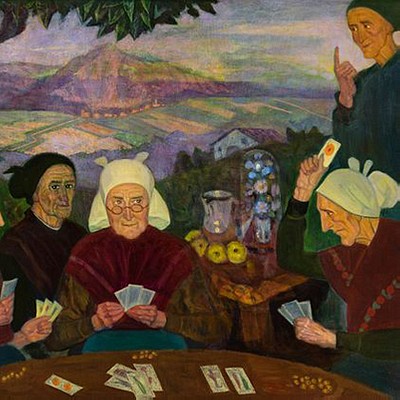BENJAMIN PALENCIA (Barrax, Albacete, 1894 - Madrid, 1980). Untitled. Oil on canvas.
Lot 64
About Seller
Setdart Auction House
Carrer Aragó 346
Barcelona
Spain
Setdart Subastas was born in 2004 and is currently the first online art auction in Spain with solidity, prestige and reliability guaranteed by our more than 60,000 users. Setdart has a young, dynamic and enterprising team ready to successfully manage the purchase and sale of art works through custom...Read more
Estimate:
EUR€4,000 - EUR€4,500
$4,210.53 - $4,736.84
Absentee vs Live bid
Two ways to bid:
- Leave a max absentee bid and the platform will bid on your behalf up to your maximum bid during the live auction.
- Bid live during the auction and your bids will be submitted real-time to the auctioneer.
Bid Increments
| Price | Bid Increment |
|---|---|
| EUR€0 | EUR€10 |
| EUR€200 | EUR€25 |
| EUR€500 | EUR€50 |
| EUR€1,000 | EUR€100 |
| EUR€3,000 | EUR€200 |
| EUR€5,000 | EUR€500 |
| EUR€10,000 | EUR€1,000 |
| EUR€20,000 | EUR€2,000 |
| EUR€50,000 | EUR€5,000 |
About Auction
By Setdart Auction House
Dec 14, 2021
Set Reminder
2021-12-14 08:00:00
2021-12-14 08:00:00
America/New_York
Bidsquare
Bidsquare : 19th & 20th Century Fine Art
https://www.bidsquare.com/auctions/setdart-auction-house/19th-20th-century-fine-art-7992
Gaudi, Sorolla, Torres Garcia, Maclet, TSUGUHARU FOUJITA, Benjamin Palencia Setdart Auction House sofia@setdart.com
Gaudi, Sorolla, Torres Garcia, Maclet, TSUGUHARU FOUJITA, Benjamin Palencia Setdart Auction House sofia@setdart.com
- Lot Description
BENJAMIN PALENCIA (Barrax, Albacete, 1894 - Madrid, 1980). Untitled. Oil on canvas. Certificate can be issued by the Archives of Benjamin Palencia, at the buyer's expense. Presents faults in the frame. Measurements: 40 x 53 cm; 59 x 72 cm (frame). Founder of the School of Vallecas together with Alberto Sánchez, sculptor, Benjamín Palencia was one of the most important heirs of the poetics of the Castilian landscape typical of the Generation of 98. With only fifteen years Palencia leaves his native town and settles in Madrid to develop his formation through his frequent visits to the Prado Museum, since he always rejected the official teachings of the Royal Academy of Fine Arts of San Fernando. In 1925 he participates in the Exhibition of Iberian Artists held at the Retiro Palace in Madrid, and in 1926 he travels for the first time to Paris. There he met Picasso, Gargallo and Miró and came into contact with the collage technique, which he would later apply to his work, incorporating new materials such as sand or ashes. It will be from this Parisian stay when Palencia's work acquires a surrealist tone, evidenced in an increasingly greater expressive freedom that will reach its fullness in his period of maturity. On his return to Madrid he founded the Vallecas School (1927), and made his individual debut at the Museum of Modern Art (1928). Palencia will gradually abandon still lifes to take up again the Castilian landscape, capturing it through a magnificent synthesis between tradition and avant-garde. This personal aesthetic of the landscape will reach its culmination in the School of Vallecas and, after a brilliant surrealist incursion in the early thirties, at the outbreak of the Civil War Palencia remains in Madrid, suffering like his peers of his generation a period of deep crisis. After the war, between 1939 and 1940 his painting took a radical turn; he abandoned the cubist and abstract influences and even the surrealist aspects, in search of an art of strong chromatic impact, linked to Fauvism. Focused on his work as a landscape painter, in 1942 Palencia took up again the experience of the Vallecas School together with the young painters Álvar Delgado, Carlos Pascual de Lara, Gregorio del Olmo, Enrique Núñez Casteló and Francisco San José. His work will gather images of the Castilian countryside and its peasants and animals; his painting becomes a testimony of the rough, the coarse and the rural, of the subtle expressiveness of the Castilian sobriety. Already fully consolidated, in 1943 he obtains the first medal at the National Exhibition of Fine Arts and in 1944 he is selected to participate in the Salón de los Once de Eugenio D'Ors in Madrid. The following year he was awarded the medal of honor at the National Exhibition, although he renounced it to facilitate its concession to José Gutiérrez Solana.
- Shipping Info
-
In-house shipping available. Please inquire at admin@setdart.com.
-
- Buyer's Premium



 EUR
EUR CAD
CAD AUD
AUD GBP
GBP MXN
MXN HKD
HKD CNY
CNY MYR
MYR SEK
SEK SGD
SGD CHF
CHF THB
THB















